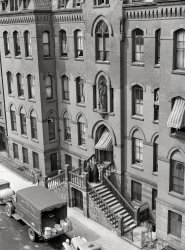
MAY CONTAIN NUTS

Search Shorpy
SHORPY ART

Framed or unframed, desk size to sofa size, printed by us in Arizona and Alabama since 2007. Explore now.
Join and Share
Ad-Free Shorpy
Shorpy is funded by you. Patreon contributors get an ad-free experience.
Learn more.

Recent comments
- Texas Flyer wanted
- Just a Year Too Soon
- WWII -- Replacing men with women at the railroad crossing.
- Yes, Icing
- You kids drive me nuts!
- NOT An Easy Job
- I wonder
- Just add window boxes
- Icing Platform?
- Indiana Harbor Belt abides
- Freezing haze
- Corrections (for those who care)
- C&NW at Nelson
- Fallen Flags
- A dangerous job made worse
- Water Stop
- Passenger trains have right of way over freights?
- Coal
- Never ceases to amaze me.
- Still chuggin' (in model form)
- Great shot
- Westerly Breeze
- For the men, a trapeze
- Tickled
- Sense of loneliness ...
- 2 cents
- Charm City
- What an Outrage
- Brighton Park
- Catenary Supports
Member Photos
The Shorpy
Print Emporium
Print Emporium
Search Shorpy
Search results -- 30 results per page
- NYT Radio Room: 1942
- September 3, 1942. "New York, New York. Radio room of the New York Times newspaper. The Times listening post, ... Posted by Dave - 11/15/2023 - 7:57pm -
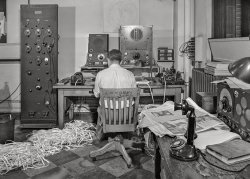
- Manhattan Skyline: 1915
- New York circa 1915. "New York skyline from Manhattan Bridge." Another entry from Detroit ... Posted by Dave - 08/05/2012 - 4:25pm -
![Manhattan Skyline: 1915 New York circa 1915. "New York skyline from Manhattan Bridge." Another entry from Detroit Publishing's series of sooty cityscapes. View full size.
BuildingsOn the far right is the Municipal Building, and to its left is the Woolworth Building.
A modern viewHere's a shot from a nearby location 100 years later.
Merchants
Chambers Printing Company
S. Giuseppe
Uneeda Biscuit
And nowA view from the bridge.
Where it isThe cross street in the foreground is Market, in what used to be Little Italy, now Chinatown. What are the two streets heading downtown? There is no wedge-shaped block like this on Market today.
What a pole!As a straight razor guy and a collector of things tonsorial, my eye was immediately drawn to, what I believe is, that great barber pole at the bottom of the photo. It looks to be part barber pole and part flag pole. I'd give my brother's right arm to have one like that.
Pineapple TowersGreat skyline picture especially especially juxtaposed behind the everyday market street at the bottom. Can anyone supply names for all those massive buildings? -- especially the one that looks like it's wearing a pineapple on top.
[The pineapple is the Singer Building. - Dave]
Hey KidCareful on that fire escape!
Madison StreetThat's Madison Street with the Alfred E. Smith Houses on the left and Chatham Green apartments on the right.
Are you sure this photo is from 1910?because The Equitable Building wasn't completed until 1915 ... and construction of the Woolworth Building was just starting in 1910.
["Circa 1910" does not mean the picture was taken in 1910. If we knew what year the photo was taken, we'd give it. "Circa" means around -- in the general vicinity. It's a starting point. - Dave]
FluffyzillaIt's not a giant lizard, a flying turtle or even the Stay-Puft Marshmallow Man, but every time I look at this portion of the photo, I see a giant bunny between the buildings, peacefully nibbling its way through the city.
Today's ViewI used Google Earth 3D buildings to align the vantage point and then looked at Street View. The buildings match (look at the one the horse is headed toward, and also the building on the block closer to the camera with arched windows).
View Larger Map
Make that New York c. 1915This magnificent view contains several skyscrapers completed after 1910. On the left we see the Bankers Trust Building, with the pyramid on top (finished 1912) and immediately to its right, the wide bulk of the new Equitable Building (finished 1915); on the right we see the Woolworth Building, the tallest in the world at that time (finished 1913) and the Municipal Building, with its cute little round temple at the top (finished 1914).
TrystLove blooms above the city's streets. Nice
Monroe StreetThis is a view looking up Monroe Street with Market in the foreground. NYCer's image is nearby looking up Madison Street with Market in the foreground.
Here's One MoreThe very white building in the middle background with the American flag waving above it is the first section of the old AT&T Building at 195 Broadway, which was completed in 1916 (the second section - not seen here - was completed in 1922).
Still ThereIf I've got it right, these two buildings are still there but now surrounded by even bigger buildings. Amazing.
[These are the Bankers Trust and Equitable buildings. - Dave]
Where it isThe exact location is the intersection of Monroe and Market streets looking west. The first picture submitted by nycer as well as the one directly above is along Madison Street, which is one block north of Monroe. The wedge shaped block was created by Monroe and Hamilton streets. Hamilton was eliminated with the construction of the Knickerbocker Village housing project in 1934. I have a site devoted in large part to the history of this project:
http://knickerbockervillage.blogspot.com
Between Monroe and CherryI think the street to the left is Monroe. The street to the right is the unnamed street circled in the map below, in between Monroe and Cherry. That would mean S. Giuseppe's store is on Catherine Street.
Most of it is gone. It's all large apartment buildings on the south side of Monroe and the West side of Catherine. The buildings on the North side of Monroe are still there.
+99This is the same view west on Monroe Street from May of 2009. The building in the right foreground remains as do its chimneys which are now covered in graffiti or hidden by transmitters.
Laundry LadyI smiled when I saw the woman on the roof hanging her wet laundry out to dry! I'm afraid I would be scared to death!
Zero'th SisterI was going to mention the interesting similarity of the building below to Moscow's "Seven Sisters," a series of wedding-cake architectural extravagances from the Stalinist era. Then I read the Wikipedia article on Stalin's buildings!
"The Manhattan Municipal Building in New York City, completed in 1915, is reportedly an architectural precursor to the Seven Sisters."
We spent a night in the Hotel Ukraina some years back. Lovely building, but very old, and to paraphrase Mark Twain, "The hottest Summer I ever spent was a Winter's night in Moscow!" 15 degrees outside, 85 inside.
[That's the Woolworth Building below. - Dave]
High and DryThis gal is just merrily hanging out her laundry with nothing between her and a fast free-fall but a few live wires! At my place of work I couldn't go higher than a common step ladder without a climbing harness and a spotter. Seems to me they worried a lot less back then and didn't try to turn everything into a liability lawsuit.
Market, Monroe and HamiltonThe original photo shows the intersection of these three streets. Hamilton Street (the one with the bend in the middle) was demapped in the early 1930s when Knickerbocker Village was built (see first photo in comments). That development was opened in 1934. At the foot of Monroe Street in the original photo there is a building marked "S. Giuseppe." That was the original St. Joseph's Church. The current structure was built in 1923 at the corner of Monroe and Catherine Streets across from the original site.
First time I ever saw a photo of Hamilton Street, great find!
My Best ShotHere is another view of the skyline in a photo I took Oct 4, 2009 from the Manhattan Bridge. I was attending the celebration of the Bridge's 100th Anniversary.
So muchfor previous claims posted here on Shorpy that cities one hundred years ago were neat, clean and litter-free.
A hot dayDid anybody else notice how most of the people on the street are crowded into the shade?
This helicopter mom is nervousAbout that child on the fire escape, who looks to be about 3 or 4 years old. That's five storeys up. Such a different world. Or, perhaps, such a different economic perspective from my middle class complacency. Mom was probably overwhelmed with six or seven kids, the housework and cooking and, perhaps, piecework to help keep the family in food and tenement rent. No time for the luxury of worry. And those windows would have to be wide open in a stifling upper storey building.
Black MariaWhat's amazing is the ominous woman striding down the left-side street dressed literally head to toe in black on this seemingly warm spring or summer day. Complete with black hat. We will never know her tragic mission; what dark news she's about to deliver to some poor soul in one of those buildings.
Biggest ChangeMy father was born in Manhattan in 1918, and died in January 2009 at the age of 90. He was raised in Greenwich Village and except for 10 years spent in Europe, he lived his entire life in Manhattan. He saw almost all of the evolution of New York during the 20th Century.
Shortly before his death I asked him what he thought was the greatest general change in New York since he was a kid. Immediately he said "The greenery ! New York is so green now! There are so many trees! When I was a kid New York was a dirty and grimy place with almost no greenery, and very few of the side streets had any trees in them. Certainly not in working class neighborhoods. If you wanted trees you went to the park. That's definitely the biggest change."
This is borne out by all these comparative pictures; not a tree in sight in 1915.
(The Gallery, DPC, NYC)](https://www.shorpy.com/files/images/4a24884a.thumbnail.jpg)
- Broadway From Dey: 1900
- New York, 1900. "Broadway looking north from Dey Street." Rising at left, the ... style, it is the oldest existing church building in New York City.
Here is the view at street level today.
... Posted by Dave - 04/06/2023 - 12:29pm -
![Broadway From Dey: 1900 New York, 1900. "Broadway looking north from Dey Street." Rising at left, the Western Union Telegraph Building. 8x10 inch glass negative, Detroit Photographic Company. View full size.
Words travel by wire, people by cableA relatively rare glimpse of cable cars in NYC -- the Metropolitan Street Railway
came late and didn't last long -- at least if the date is correct: unlike most areas, Manhattan went from cable cars to conduit-powered streetcars, so it's hard to tell by the trackwork alone. But the cars seem a match.
[The streetcars in our photo look a lot more like the electric streetcars seen here. - Dave]
Could be: the changeover date was May 25, 1901, so the premise rests entirely on exactly what the date is...I'll trade my comment for a "circa". - N
And upon this rock they built a churchAt center left is St. Paul's Chapel. Built in 1766 in the Georgian style, it is the oldest existing church building in New York City.
Here is the view at street level today.
Wherefore art thou?A remarkable lack of women out and about in 1900.
Rush hour traffIcNew York City has changed little in the last 123 years, huh?
Clang, clang, clang went the trolleyAccording to one source, it wasn’t until about 1909 that electric trolleys were pressed into service in New York. Prior to that there were ‘cable cars,’ as evidenced in the post. Looking carefully one can see the cable stretched out between the rails of each line.
[The electrification of Manhattan's streetcar lines began in the 1890s. That's not a cable between the rails -- it's a slot over the electrical conduit under the street. - Dave]
Frequency of serviceFor me the most interesting thing about this picture is the interval between the streetcars, which is close to NOTHING.
OK, maybe there's heavy traffic, and a bunch of them got jammed up together ... but looking off to the north it appears that there's just a steady stream of streetcars.
Imagine how this would change city life if we tried this today, with trolleys and buses.
New York City's first great hotelThat's Astor House up past St. Paul's. After it opened in 1836, it became New York's first great hotel, for many years the (unofficial?) headquarters of the Whig Party, and the favorite place of Senators Henry Clay and Daniel Webster, who told the NY Times he "would stay at no other hotel." Thurlow Weed supposedly lived there for 30 years. Photographer Mathew Brady lived there, and Thomas Edison stayed there when visiting from Menlo Park. William James was born there in 1842.
http://www.tribecatrib.com/sites/default/files/imagecache/standaloneslid...
https://upload.wikimedia.org/wikipedia/commons/thumb/f/fc/Astor-loc.jpg/...
(The Gallery, DPC, NYC, Streetcars)](https://www.shorpy.com/files/images/SHORPY-4a55070a.thumbnail.jpg)
- Hotel Dixie: 1950
- New York's 43rd Street, just off Times Square, circa 1950. "Hotel Dixie -- 700 ... of the bus depot still there Article at Scouting New York .
Rooms with Radios
New York Times, November 10, ... Posted by Dave - 02/03/2015 - 10:16am -
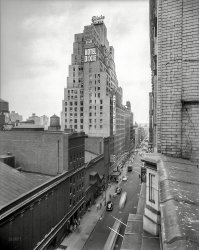
- Now Playing: 1920
- "York Theater, night." Washington, D.C., circa 1920. Among the cinematic ... that was once a reasonable mode of transportation!
New Photoplay House
Builds Eighth 'Movie'
Harry M. Crandall ... designed for the theater. The unique feature of the new system will be that heat will be blown in from the ceiling. The same ... Posted by Dave - 07/17/2012 - 10:16pm -
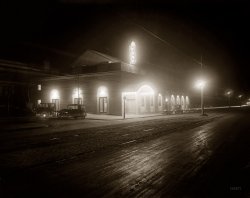
- The Heart of New York: 1907
- Circa 1907. "The heart of New York (Manhattan skyline from Brooklyn)." The Singer Building rises. 8x10 glass ... The best views of Manhattan are from Brooklyn, Queens and New Jersey.
Singer Tower The Singer (sewing machine company) tower, ... Posted by Dave - 08/21/2012 - 12:38pm -
![The Heart of New York: 1907 Circa 1907. "The heart of New York (Manhattan skyline from Brooklyn)." The Singer Building rises. 8x10 glass negative, Detroit Publishing Co. View full size.
Ghost TownNot a soul in sight!
[They are there, just really tiny. - Dave]
Even TodayThe best views of Manhattan are from Brooklyn, Queens and New Jersey.
Singer TowerThe Singer (sewing machine company) tower, under construction was the tallest building in the world for a couple of years. It was demolished at a youthful 60-years old.
Tall ShipsIt is interesting to see ships with masts and sails plying the waters around Manhattan. There is a large three masted ship tied up to the pier, slightly left of center. I can remember going to The South Street Seaport Museum to look at the Peking and the Wavertree.
Indecently, the South Street Seaport Museum is located at Pier 16 On the East River. Pier 16 is the right hand pier of the two Mallory Line Piers.
Transportation History DivinedI just realized how the waterfront railroad terminals in New Jersey worked!
If you look closely, several of the barges are from the Lehigh Valley Railroad, which ran from that region of Pennsylvania to Jersey City. I must presume that the goods that were to be transshipped from freight cars to ships or the city itself were loaded on to barges and then delivered to the deep water piers in Brooklyn and Manhattan for delivery in the city or loading on to ocean going vessels. Thus explaining why all the great photographs I've seen on Shorpy feature so many small barges, lighters, and other riverine craft.
I imagine the completion of the New York Central Railroad's High Line was a serious blow to the LVRR and other lines on the New Jersey side of the Hudson and the Holland Tunnel doubly so. Imagine what New York City would be like if there had been a more efficient rail system from New Jersey to the docklands of the East River.
How did it take me so long to figure this out?!
What's going on here?Heavy traffic out there! Up until the 1960s-1970s, various railroads transferred huge amounts of cargo to and from the city by barges called carfloats carrying rail cars. Several railroads had small switching yards isolated from their main lines fed by carfloats, plus warehouses as well. Those railroads also often had their own “navies” of tugs and barges to transfer cargo to and from ships in the harbor..
Note the covered barges (AKA house barges) in the foreground marked for the Lehigh Valley RR. The one at far right is owned by the Lackawanna RR. The covering structure allowed secure storage and protected cargo from the weather during transfer. Covered barges had side doors to allow direct transfer to freighters that also had side doors. The freighter in foreground right looks to be transferring cargo via one of the barge’s roof hatches located over its side door.
At far left are 2 hold barges, apparently one with coal being loaded onto the ship alongside. Those barges were mostly owned by coal companies.
A stick lighter (AKA gas hoister) is at bottom right with others elsewhere in the picture. Essentially a derrick on a barge, they were used to handle heavy/bulky items. The bigger one opposite is a self-propelled steam lighter. Those were used for making faster transfers of goods – no waiting for tug service.
A good reference is “New York Harbor Railroads in Color, Volume 1” by Thomas R. Flagg (Morning Sun Books, 2000)
(The Gallery, Boats & Bridges, DPC, NYC)](https://www.shorpy.com/files/images/4a22396a.thumbnail.jpg)
- New York Giants: 1900
- New York, 1900. "St. Paul and Park Row buildings, two tallest buildings in the ... for his 2nd term campaign. The extract I posted from the New York Times (deleted by Shorpy, I guess) was in preparation for his 1st ... Posted by Dave - 07/19/2012 - 11:38pm -
![New York Giants: 1900 New York, 1900. "St. Paul and Park Row buildings, two tallest buildings in the world." Note the campaign banner at the bottom of the photo, shot from the Woodbridge building. 8x10 glass negative, Detroit Publishing. View full size.
Tiny Sample HatsWhen we emptied out my parents' house of 54 years worth of stuff saved, I found two small miniature oval hat boxes in perfect condition from Knox Hats. Each contained a finely detailed sample of one of their products and I saved them because they were so unique. After seeing this picture today I put "Tiny Knox Hats" in the search space and came up with pages of info, several of which were people selling salesmens' samples of same. I had no idea these are collectible and now I have to find the ones I brought home which were not shown on the "vintage collectibles" auctions. My father always wore a hat and he had many including Knox, Adams, Dobbs, Stetsons, Danbury, Russian fur, Panamas, etc. and I donated them all to a thrift store. Now I wish I had them. We get too soon old and too late smart.
Man on LedgeIf you look at the building (the one with all the window shutters open) to the right of the Knox the Hatter building, you will see a man standing on a ledge on the floor just below the roof. There is a large oil or water tank to his right. I don't think he was a window washer. Could he have been a sign painter who was about to paint a message on the large black rectangle on the side of the building right in back of him? To say that he is perched precariously would be an understatement.
DPOC TCCThey'd probably just turn themselves into an acronym today
I would say the photo is circa September 26, 1896.
[McKinley ran with Roosevelt in 1900, not 1896. Also, the Woodbridge Building was erected in 1897. - tterrace]
Whoops, I stand corrected. This was for his 2nd term campaign. The extract I posted from the New York Times (deleted by Shorpy, I guess) was in preparation for his 1st term.
Hat HistoryKnox the Hatter was clearly a mover and shaker in Old New York. Read all about it here and here.
Knox the HatterDuring my commuting days I remember seeing a Knox Hats shop on 8th Ave across the street from the Port Authority. They had a beautiful neon sign and it stood out from the other grimy storefronts along the street.
Armeny & Marion PensIn the early 1870's Armeny & Marion Co. made extension pens under their own name, but they soon began to make these along with gold filled caps for stylographic pens and gold bands to supply other pen makers. Armeny & Marion Co. was a very early investor in Lewis Waterman's Ideal Pen co.
Armeny & Marion Co
Skyscrapers in search of a paradigmIt's interesting to see that these structures are, despite their giant size, still following the model of the storefronts and brownstones at the bottom of the frame -- embellished street-front facades, with the rear and sides very plain or totally unadorned, resulting in two or three completely different architectural treatments for the same building. Note the blank-faced section of the St. Paul facing us, fronted with a zillion bricks, enclosing the ventilation and elevator or stair shafts. It looks like an urban grain elevator. (For the street-front sides, see this view.)
Where's the water?The first thing I noticed are the missing water towers. I see a few, but if you look out onto NYC rooftops today all you'll see are the water towers, looking like fat, rusty spaceships.
Park Row & St. Paul 1908This postcard from a New York City friend, was sent to my grandparents in August of 1908.
May have answered my questionI think I may have found the reason why the aforementioned man is perched on the ledge of the building with all the shutters open. I started looking more closely and discovered that there is another man two floors below and slightly to the left that seems to be on a scaffold. It looks as though he is painting the shutters. If you look in back of the first man higher up, you can see a bucket. It looks as if these two were painters. This would also explain why all the shutters were thrown open the way they were: they had just been painted and were in the process of drying.
Bldgs and streets?Can someone please post a current view, and ID the tallest spires and the streets that are visible? Is that the old Post Office to the right of the 2 skyscrapers? Is view to west or northwest?
(The Gallery, DPC, NYC)](https://www.shorpy.com/files/images/SHORPY_4a08588a.thumbnail.jpg)
- New York Public Library: 1910
- New York circa 1910. "New York Public Library, Fifth Avenue at East 42nd Street." 8x10 inch dry plate ... Posted by Dave - 08/14/2012 - 2:11pm -
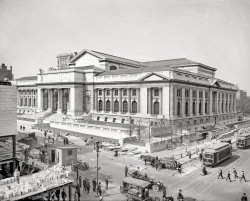
- New York City Photo Map
- The map mashup below combines recent Shorpy images of New York City with their location on Google Maps. Clicking on a point will bring up ... Posted by Ken - 10/24/2007 - 2:44pm
- New York Nuts: 1900
- New York circa 1900. "Peanut stand, West 42nd Street." Note the horsecar heading ... address of the Liverpool & London Insurance office in New York, circa 1900?
[Hint: N.Y. Times archive. - Dave]
Liverpool ... Posted by Dave - 09/13/2011 - 11:30am -
![New York Nuts: 1900 New York circa 1900. "Peanut stand, West 42nd Street." Note the horsecar heading this way. Detroit Photographic Company glass negative. View full size.
UPDATE: A bit of sleuthing reveals the location here to be 230 Grand Street.
Hot Peanuts! Hot Peanuts!From Jakey the Peanut Man ...
(Dave, if you want to use this track, please fix it up to work with that built-in music player the way you did with "Yellow Dog Blues").
[All you need to do is copy and paste the "embed" code on your download page into the comments box. - Dave]
I think it's 230 W 42The address looks to be 230 W 42 St which means the building is the one with a McDonalds at street level. The magnificent pillars (and building I am sure) next door are gone, replaced by The Amsterdam Theatre.
[As it turns out, this is not 42nd Street at all, and the foreground buildings still exist. Who can figure it out from the clues in the photo? - Dave]
DirectionsI don't see a single familiar landmark. What's really confusing is the mass of buildings blocking the horizon.
East and WestThe shadows would indicate that this is looking west toward the Hudson, but the photos show buildings at the end of the street, rather than it being open to the river view. That doesn't seem right to me. It would also be interesting to learn what the building with the large columns on its facade might have been -- a bank, a theater or a church, maybe. Anyone have the answer?
Lost smellsAny given space that has survived a century or more will sound and smell very differently than it once did. An 1880 house has known sounds and scents that are now lost to us.
Same deal with this street. It is hard for us to imagine what this street sounded like, with no (or rare) horns (that sounded very different anyway), no cars and their many levels of sound, no booming stereos. Wagon wheels on cobbles or bricks. Hooves. Trolley bells. Hobnails. The smells are easier. Mostly horse dung, outhouses, sweaty people, and this fellow's peanuts.
W. 42ndThe address behind them looks to be 280 West 42nd, which would be on the south side of the street, meaning that the camera is pointed east toward Times Square. Probably none of the buildings shown still exist.
The horse-drawn trolley may be the least anachronistic thing here. There are stables just a couple of blocks south of this location, and one often sees horses and carts in the street today.
[If we're looking east, it means the sun is shining from the north -- a neat trick in the Northern Hemisphere. - Dave]
View Larger Map
Liverpool and LondonAnybody have an old phone book in which they can look up the address of the Liverpool & London Insurance office in New York, circa 1900?
[Hint: N.Y. Times archive. - Dave]
Liverpool and LondonI looked up the Liverpool and London insurance company. They had a branch office at 66 Wall Street. Could that be right? The building with the large columns in the background doesn't look the kind usually find on 42nd Street, no matter the century.
[Not Wall Street. - Dave]
I'll hazard a guessI believe the company whose sign you can partially see is the Liverpool and London and Globe Insurance Company. The pillars indicate the financial district, but the street seems too wide for most of it.
But the L&L&G Co. did have an office on Broadway, or so Google tells me. Exactly where on Broadway, I don't know.
[Not Broadway. - Dave]
It's not 42nd Street!It's not a photo of 42nd Street. This is The Bowery Savings Bank built in 1895 by Stanford White. The location of this photo is 130 Bowery Street. The peanut seller is standing on Grand Street. It's no longer a bank but is the Capitale (restaurant/wedding event hall). The view of this photo is looking toward Little Italy and Chinatown. It's a beautiful landmark building.
[You are right about some of the details, although the address is not 130. Next! - Dave]
Williams StreetWilliams Street near Wall Street?
[Noop. - Dave]
230 Grand StreetIt's 230 Grand just of off Bowery.
I can go back to work now!
[Dingdingding. We have a winner! - Dave]
View Larger Map
Liverpool & LondonThe address for the Branch office of Liverpool & London is 230 Grand Street. The Bowery Savings Bank address is 130 Bowery Street (main entrance). This photo is the view of the side entrance to the bank on Grand Street.
[Dingdingding. Retroactive winner! Gustav Frank was the manager at Liverpool & London & Globe. - Dave]
View Larger Map
(The Gallery, DPC, Kids, NYC)](https://www.shorpy.com/files/images/4a09001a_0.thumbnail.jpg)
- Fifth Avenue Stage: 1900
- New York circa 1900. "A Fifth Avenue stage." 8x10 inch dry plate glass negative, ... and forced to pull a lot of humans around the streets of New York. Might be, "My peeps can't even get me to walk on a leash with them." ... Posted by Dave - 08/05/2018 - 4:02pm -
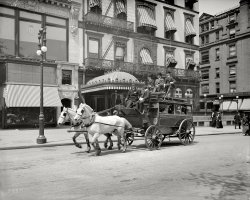
- New York Stock Exchange: 1904
- Lower Manhattan circa 1904. "New York Stock Exchange, Wall and Broad streets." Note the not very successful ... Paul Wayland Bartlett and executed by Piccirilli Bros. of New York. In 1936, the 90-ton sculpture was replaced by a 10-ton replica. - ... Posted by Dave - 08/08/2012 - 7:12pm -
![New York Stock Exchange: 1904 Lower Manhattan circa 1904. "New York Stock Exchange, Wall and Broad streets." Note the not very successful attempt to retouch three ghost pedestrians out of the picture. Detroit Publishing Company glass negative. View full size.
An Inquiring Mindwould like to know who sculpted the magnificent facade.
["Integrity Protecting the Works of Man" was designed by John Quincy Adams Ward in collaboration with Paul Wayland Bartlett and executed by Piccirilli Bros. of New York. In 1936, the 90-ton sculpture was replaced by a 10-ton replica. - Dave]
re: Tight Security NowI visited in 2002 and was surprised to find cops with assault rifles patrolling the barricaded street. I asked one what the special occasion was. He asked, "what do you mean?"
What an odd sculptureLike everyone is looking for their lost contact lens. Not to mention their clothes.
I guess we'll never knowI wonder why the photographer attempted to remove those specific persons from the shot.
[Because they're aesthetically imperfect and distracting! Most likely the photographers did not do the retouching. On the final product -- a colored postcard -- our blurry pedestrians would be completely obliterated. - Dave]
Tight Security NowThis is one of the most magnificent streets in all of NYC but now has extremely tight security - you can no longer drive on this street, there are metal barriers around the front of the NYSE so the average person can't walk up to the building, police have quite a presence there now, and last month I saw some kind of bomb detection trunk near there. They do fly the world's largest American flag in front of the pillars which helps but unfortunately obstructs the pillars of this beautiful building.
The Silver Surfer and FamilyActually it looks like The Silver Surfer has gone back in time with his family on holiday. The photographer appear to have used Photoshop Ver.-107.
J.P.This image shows a great juxtaposition between the Iconic Wall Street Exchange and J.P. Morgan's office building. I can picture him walking out of there with that huge cigar of his, on the way to some deal.
Old GloryRespect etc. to the flag, but the building did look much better without it.
Interesting FacadeWhile the Stock Exchange is quite tall, its design avoids the presence of any windows more than two floors off the ground. Perhaps the architect was looking ahead to 1929.
Con Edison workerOn the extreme left of the photo is what appears to be a utility worker with his feet in a manhole and a temporary barrier setup. It is amazing what is frozen in time. Also I love the old style fire hydrants I believe they were phased out by around 1915, in my current town of Danbury, Connecticut, there is one just like it painted yellow on a forgotten triangle of land.
Air ConditioningDoes anyone have any photos of the air conditioning system that was installed in this building? It had a 300-ton comfort cooling system designed by an Alfred Wolff that used free cooling provided by a waste-steam-operated refrigeration system. It worked for 20 years. I'm researching it for an environmental controls class. Thanks!
+108Below is the same perspective from April of 2012.
(The Gallery, DPC, NYC)](https://www.shorpy.com/files/images/4a11676a.thumbnail.jpg)
- German Band in Buffalo, New York
- ... band. Bringing a taste of Bavarian music to Buffalo, New York, in 1925. View full size.
(ShorpyBlog, Member Gallery) ... Posted by phlyx - 10/30/2022 - 11:21am -
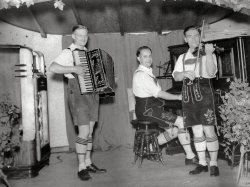
- Wisdom, Montana: 1942
- ... ride. It was a short 20 mile drive. Would move back in a New York minute.
Early pioneers of the Big Hole I'm looking for any pictures ... Posted by Dave - 11/03/2023 - 1:14pm -
![Wisdom, Montana: 1942 April 1942. "Baker's Garage in Wisdom, Montana. Largest town, population 385, in the Big Hole Basin, a trading center in ranching country." 4x5 Kodachrome transparency by John Vachon for the Office of War Information. View full size.
Superb quality!The quality of this photograph is amazing. It looks like it was taken today. Do you have any more information on it?
Wisdom MTGoogle Maps link.
WisdomGreat photo. Thanks. The last remaining inhabitants eventually changed the name to "Boredom, Montana."
Towns like thisTowns like this are a staple of western North America. In western Canada, their existence was justified by the railway and farmers hauling grain to their local elevators. Later they survived when the highway became the big thing and people stopped for gas or a little food on the road. There's probably a bar that the locals go to. Town's got a school maybe even a high school, and probably more than one church. There's a ball field and, in just about every prairie town in Canada though of course not the USA, a curling rink. In Saskatchewan they used to say that if you lived in a town that lost the school and the curling rink you might as well start looking for a place in Saskatoon or Regina.
PennzoilThe Pennzoil logo hasn't changed much:
WidsomIt looks like it's on the edge of a river valley? The colors in this shot are indeed amazing. I love the punch of the red gas pumps.
[It's west of Butte. - Dave]
CalsoWhat does it say on the sign leaning against the wall, underneath "Calso Gasoline"? Is that "Unsurcharged"? No extra fees?
["Unsurpassed." - Dave]
Eternal WisdomUnderneath "Unsurpassed" on the Calso sign you have "The California Company"
I found a modern picture of this place online:
http://www.panoramio.com/photo/4494303
Aside from the paved road, this place looks much the same. I don't think they sell Chevron or Mobil at those buildings anymore. Baker's Garage is now Conover's Trading Post. The painted Wisdom has long since faded from the old metal roof.
The GarageI was raised and went to school in wisdom and Bakers Garage is not next to Ed Glassey's garage (The building with Wisdom on the top). Baker's Garage was across the street from Glasseys Garage (Looks like maybe they used photoshop to alter the photo) ..
I moved to Wisdom in 1959 so if the photo is from 1942 maybe they moved the Building??
[The image, which is part of the Library of Congress photographic archive, has not been altered. It's one of more than 50 pictures of Wisdom taken by John Vachon in April 1942. Things can change a lot in 20 years. - Dave]
Baker's Garage in WisdomI am a Wisdom native too.
In talking to my dad. Bruce Helming, who is the oldest native still living in Wisdom, it turns out that Anna Lee and Roy Baker did own a shop across the street from the garage that you know as Baker's, which is now the Wisdom Market. It was the Chet Bruns Union 76 Garage back in the old days. Anna Lee was my dad's first cousin. Dad's folks adopted her when her parents died in the 1920s, and she was raised as Anna Lee Helming in Wisdom.
My grandparents' (and later Dad's) business, Helming Brothers, bought out Chet Bruns' operation in the 1950s, which is when Anna Lee and Roy moved to the garage that you know now. The buildings shown in the photo were destroyed in the American Legion hall fire. I would guess that was in the early 50s, which is when all of the cemetery records were destroyed.
Wisdom had no real fire department until 1961, so when a blaze was raging out of control, it was extinguished by placing dynamite in a loaf of bread and tossing it into the fire. The night the Legion hall and all of these other buildings burned, Dad and his uncle, Clarence Helming, were bringing the fire pumper to the scene. Just as they rounded the corner, "Boom," no more fire (and no more buildings).
Gary Helming
Helming@juno.com
Pictures of Wisdom, MontanaI enjoyed looking at the old pictures of Wisdom and reading the text about them. I grew up near a small town (Gladstone, VA) and have always been kind of partial to them. I love looking at old pictures like these. Thank you for posting them.
The Wisdom of YouthThis town holds a place in my heart. I spent most of my youth in Wisdom, from 1975 to 1990. The town hasn't changed a lot since I left, but has gotten smaller. When I started at Wisdom Elementary there were four classrooms. By the time I graduated to high school they were down to three. I hear there is only one class there now. For high school we were bused 65 miles to the Dillon, one of only two high schools in the county.
It was an amazing place to grow up. Though everyone knew your business, everyone kept an eye out for you. We had two bars that all the kids hung out in and played pool. There were street dances for the Fourth of July and any other occasion. There were two restaurants, one of which burned down last week.
It is hard to describe the life that a kid in a town this small would lead. The concept just doesn't make sense to city folk. But it was an amazing carefree life of swimming under the bridge, ice skating at the pond, nights of kick the can in the Forest Service field, greetings from the town's pet deer and raccoons.
If it were possible to have the kind of lifestyle I have now in the city, I would move back to raise my child there in a heartbeat.
Having lived near Wisdom for many yearsduring the summer-time, I can almost see the buildings. We haven't lived in Jackson for 20 years but the previous 8 years were spent on the Hairpin Ranch in a line shack about 5 miles past the main ranch, in the middle of nowhere. I loved EVERY minute of it. We traveled to Wisdom for dinner some days or just when the kids wanted to take a ride. It was a short 20 mile drive. Would move back in a New York minute.
Early pioneers of the Big HoleI'm looking for any pictures or info of the early Wisdom families prior to 1930. I have an old school picture dated 1914/15 and would love to have someone help identify the children. Both sides of my family, the Elliott's and Scollicks were early settlers there. The old dilapidated log cabin on the south end of the Ruby near Butler Creek is the Scollick homestead and the Elliott log cabin is on Gibbonsville road. I believe my Aunt Eve Scollick might have married a Ferguson in the Wisdom area. There's a picture hanging at the Crossing/Fetties with several people on horses. Anyone that can help identify them as well would be great.
(The Gallery, Kodachromes, Gas Stations, John Vachon, Rural America, WW2)](https://www.shorpy.com/files/images/1a34284u1.thumbnail.jpg)
- The Great Reporter: 1942
- September 1942. "New York, New York. Photographic department of the New York Times newspaper. One of eight ... Posted by Dave - 11/27/2023 - 12:42pm -
![The Great Reporter: 1942 September 1942. "New York, New York. Photographic department of the New York Times newspaper. One of eight staff photographers returns to staff room after assignment. Over door is eulogy of news camera. At left are maps of the city and region for photographers' reference." Acetate negative by Marjory Collins for the Office of War Information. View full size.
Eight Is Enough?I would have thought the NYT at that time would have had more then than eight staff photographers.
[Photos in the Times came from staffers, freelancers and wire services. - Dave]
Dave, while I agree that photos also came from, freelancers, UPI and AP wire services for all metropolitan newspapers, my father, Joe Kordick, at that time was one of over 25 staff photographers for the newly founded Chicago Sun.
Since the NYT was a larger paper, located in the largest city in Country, I find it hard to believe that their "staff" only consisted of eight.
[The Sun was a "picture newspaper." The "Gray Lady," as the name implies, was anything but. The NYT in-house newsletters from the 1940s list from seven to nine staff photographers. - Dave]
A Wonderful LifeLooks like he's gonna count Zuzu's petals.
Photo, far rightIs that Neville Chamberlain? Also, my dad, who flew torpedo bombers in WWII, said they had something like "The Great Reporter" over the door of the ready room on the aircraft carrier. But it said "I am the best damn aviator that ever flew."
(The Gallery, Marjory Collins, NYC)](https://www.shorpy.com/files/images/SHORPY-8d08931a.thumbnail.jpg)
- New York Underground: 1904
- New York circa 1904. "14th Street subway station, construction." 8x10 inch dry ... a lot of sadness. This photo captures the essence of New York, in that all began with dust, and will end in dust.
I spent far ... Posted by Dave - 08/14/2012 - 11:36am -
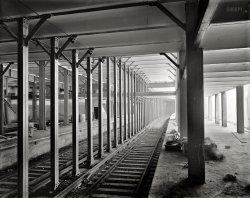
- The Wire Room: 1942
- September 3, 1942. "New York, New York. Wire room of the New York Times newspaper. Copy boy about to tear off ... Posted by Dave - 11/16/2023 - 11:12am -
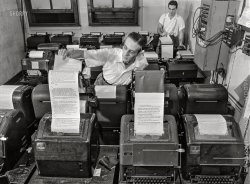
- New York Squared: 1903
- Circa 1903. "Herald Square, New York." With Times Square in the distance, and the New York Times building going up at center. Other landmarks include Macy's, the ... Posted by Dave - 09/21/2014 - 12:31pm -
![New York Squared: 1903 Circa 1903. "Herald Square, New York." With Times Square in the distance, and the New York Times building going up at center. Other landmarks include Macy's, the New York Herald newspaper building, Sixth Avenue elevated tracks and Hotel Astor. 8x10 inch glass negative, Detroit Publishing Company. View full size.
What's the point of wearing PearlsIf no one can detect them?
Absolutely FireproofThanks to our asbestos carpets and bed linens.
As was the popular styleLots of swells in Herald Square on this fine day.
Time and - temperature?Try as I might, the internets did not reveal what the dial on the right of the Herald building indicates. However, stories of Minerva, the owls, and 'Guff n Stuff' the bell ringers abound. None of the photos I found were any more detailed than this one, but perhaps it was a thermometer?
[The answer is here, courtesy Shorpy. -tterrace]
Next StopThe next stop on the Northbound 6th Ave EL appears to be 38th Street However after I Wiki'd it, I have decided that that it was 42nd St as the 38th Street Station didn't open until 1913. That fabled line was torn down around 1940 and the steel was supposed to have been sold to the Japanese.
Watch out!The 1903 equivalent of texting while walking. Reading while walking.
Cable carsHow long did they have a cable car system? I had never heard of it before.
[There were no longer any cable trolleys in Manhattan at this time. The center slot provides access to an electrical conduit. -tterrace]
(The Gallery, DPC, NYC, Railroads, Streetcars)](https://www.shorpy.com/files/images/SHORPY-4a11541a.thumbnail.jpg)
- Flushing New York: 1943
- March 1943. "New York, New York. Department of Sanitation street flushing sprinkler truck." One in a ... Posted by Dave - 03/07/2013 - 12:33pm -
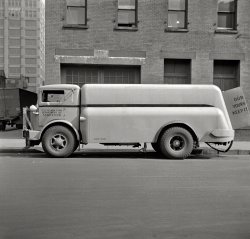
- Photoengraving Dept.: 1942
- September 1942. New York. "Photo engraving department of the New York Times newspaper. This camera photographs a photographic print through ... Posted by Dave - 11/27/2023 - 11:27am -
![Photoengraving Dept.: 1942 September 1942. New York. "Photo engraving department of the New York Times newspaper. This camera photographs a photographic print through a screen and produces a strip negative." Acetate negative by Marjory Collins for the Office of War Information. View full size.
A picture I can smell! Neighbor next door had a print shop. The smell of Developer, Stop and Fix is something that never leaves your memory.
"This camera ... "Where's the camera? At the far end of the rails?
[The entire giant apparatus is the camera. - Dave]
Probably another chapter of:Lost technologies.
Typesetters, lithographers, and so on, and all their supporting trades and professions, too. Like typecasters. Or the folks who quarried the very specific quality of limestone required by the lithographers.
Machinery as well. Linotype, anybody?
Litho CameraIn the early 70's I was enrolled in a local technical college in the "printing" course. We used a camera similar to this to shoot layouts which were imaged to large sheets of litho film (b/w) which we would develop.
Color photographs were shot with an overlay of transparent dot grids one at a time, which would collect the 4 colors present, and these were used to create the 4 individual plates to burn to print plates.
Quite a process, but very interesting for a young guy who always wondered just how do these pictures get printed.
All lighting in this darkroom was under a red lamp. Even a small spark would expose the raw litho film.
(Technology, The Gallery, Marjory Collins, NYC)](https://www.shorpy.com/files/images/SHORPY-8d08924a.thumbnail.jpg)
- Little Falls: 1941
- ... 1941. "Looking toward the Mohawk River. Little Falls, New York." Which is at least a two-stoplight town. Medium format negative by John ... Posted by Dave - 12/05/2023 - 3:42pm -
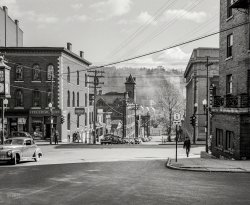
- Peas Train: 1942
- ... "Special train carrying agricultural workers to upper New York state to work in the harvest." Our second look at the high schoolers ... Posted by Dave - 01/01/2023 - 4:45pm -
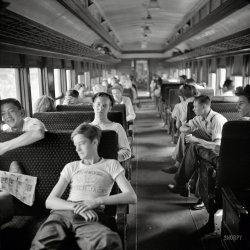
- New York Central: 1900
- Circa 1900. "New York Central R.R. photographic car." Possibly one of the "specials" ... as a small overhead chain. In the first generation of new Amtrak cars, the system was electrified, and the conductor used it to ... Posted by Dave - 05/17/2014 - 11:01pm -
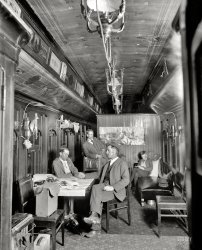
- York Village: 1908
- Circa 1908. "Street in York Village, York, Maine." Where perambulating is encouraged and moseying is ... from the "confederate" soldier, near where they built the new library. How do I post google street views to show what I'm talking ... thing is a horse trough. There are quite a few around New England usually made of granite and often with inscriptions. I have seen ... Posted by Dave - 11/28/2013 - 8:20am -
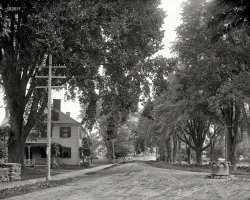
- Evening Amusements: 1900
- Circa 1900. "U.S.S. New York -- evening amusements." Quite a bit of cutting up here, in one instance ... Detroit Publishing Company. View full size.
USS New York LPD-21 Fast forwarding to November 7, 2009, I attended the ... Posted by Dave - 10/03/2012 - 6:39am -
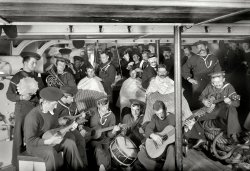
- New York Skyscrapers: 1908
- New York circa 1908. "Broadway and Trinity Building." With the Singer tower ... American patriots who died in British prisons in New York during the Revolutionary War. - Dave]
Tombstones It appears ... Posted by Dave - 06/22/2014 - 7:24pm -
![New York Skyscrapers: 1908 New York circa 1908. "Broadway and Trinity Building." With the Singer tower bringing up the rear. 8x10 glass negative, Detroit Publishing Co. View full size.
What's going on?Can't figure what's happening.
Are the bride and groom figures dummies, or real people?
There seem to people silhouettes stuck up in the park.
Watching the world go by.I can only spot one person sitting on the sill looking out onto the world.
Cool banners flying the pinnacles of the buildings.
Unfurl That AwningYes, lower that shade.
Just married?Interesting pair sitting on the steps of the big gothic monument in Trinity Churchyard. To my untutored eye, it looks like someone in a dark suit next to someone dressed all in white. Any chance of a closeup?
And can anyone ID the monument? I did a cursory search, but came up with nothing.
[The monument on whose steps this couple are resting is the Martyrs Memorial, aka the Independence Memorial Spire, erected in 1852 to commemorate American patriots who died in British prisons in New York during the Revolutionary War. - Dave]
TombstonesIt appears to be a graveyard around the monument. Can't figure out the "couple" on the steps though.
[A man in a straw hat and a Yeti. -tterrace]
Too busy to look out the windowThe guy two floors down from the still sitter may have been too busy to watch the world go by, but he made sure he kept a clean collar handy. That one practically glows in the dark.
Trinity and United States Realty Buildings The two gothic skyscrapers pictured are the former Trinity and United States Realty Buildings designed by Francis H. Kimball and constructed between 1904 and 1907. They both still exist and are Landmarks.
(The Gallery, DPC, NYC)](https://www.shorpy.com/files/images/SHORPY-4a22979a.thumbnail.jpg)
- New York Telephone: 1950
- ... building, from a helicopter." Photo by Al Ravenna for the New York World-Telegram & Sun. View full size.
No longer on the ... Posted by Dave - 07/07/2020 - 2:00pm -
![New York Telephone: 1950 February 15, 1950. "N.Y. Telephone Co. headquarters and the World-Telegram building, from a helicopter." Photo by Al Ravenna for the New York World-Telegram & Sun. View full size.
No longer on the waterfrontToday the N.Y. Telephone Co. headquarters is known as One Hundred Barclay. [Which is the designation for the residential part of today's Verizon Building. - Dave] Built in 1927, the building has survived a lot: a major fire in 1975, very seriously damaged in 2001 by both collapsing World Trade Center towers and Seven World Trade Center, then flooded during Hurricane Sandy in 2012.
See: https://daytoninmanhattan.blogspot.com/search?q=ralph+walker%27s+1927
The piers and Lackawanna Railroad have been replaced by new buildings on landfill.
Narrow escapeThe New York Telephone headquarters became the Verizon Building. On September 11, 2001, it was immediately adjacent to 7 World Trade Center and across the street from 6 World Trade Center, both of which were destroyed. The Verizon Building's thick-walled masonry construction saved it.
The Barclay-Vesey buildingThis building is a masterpiece by architect Ralph Walker. It was heavily damaged by the collapse of the WTC buildings on 9/11, but repaired at a cost approaching a billion dollars. Half of the building has recently been transformed into residences.
Here is the original lobby:
TodayLooks like both buildings are still there, although they're not as imposing now that they're surrounded by newer, taller skyscrapers. The telephone building is on the West Side Highway at Vesey Street.
Washington MarketYou can read a little more about the demise of the Washington Market (across the street from the NY Tel building in the picture above) at WNYC](https://www.shorpy.com/files/images/SHORPY-56253u.thumbnail.jpg)
- Herald Square: 1908
- New York circa 1908. "Herald Square." Panorama composed of two 8x10 inch glass ... showing Broadway at 34th Street. Landmarks include the the New York Herald newspaper building (with its clockwork blacksmith bell-ringers ... Posted by Dave - 12/02/2020 - 2:40pm -
![Herald Square: 1908 New York circa 1908. "Herald Square." Panorama composed of two 8x10 inch glass negatives, digitally merged, showing Broadway at 34th Street. Landmarks include the the New York Herald newspaper building (with its clockwork blacksmith bell-ringers and electrified owls), Sixth Avenue elevated tracks, New York Times building and Hotel Astor. Detroit Publishing Co. View full size.
James Gordon Bennett MonumentThe New York Herald Building was built in 1893 and demolished in 1921. The statue of Minerva, the clock and two owls were saved and are now part of a monument to James Gordon Bennett.
The Mighty HippodromeThe largest theatre in the world at the time, the Hippodrome, can be seen far down the tracks on the right.
Hotel Normandie"Absolutely Fireproof"
Made of 100% Asbestos.
Wow!Just WOW!
An amazing photoThe details are unbelievable. Hours can be spent just studying this photo and I likely will.
"Electrified" owlsSo what did Herald's "electrified" owls do? Light up or move? And what is the tall skinny building just left of the Hotel Astor?
[The owls' eyes lit up at night. The skinny building is the New York Times. - Dave]
Can you find?A head without a hat. I couldn't.
Too much... This one is giving me data overload! So much to see in the image!
It must be a warm Spring or Summer day because I see a lot of men sporting skimmers (flat topped straw hats) and the women are wearing blouses with shorter sleeves and fancy hats.
Toward the lower left of the photo we see a cab (horse drawn type) with the driver, in his top hat, waiting patiently. I suspect that I can see a slight smile on his face. Perhaps there is a pretty girl in his field of view.
Then, there are the two members of the constabulary conversing together, in the lower center of the picture. maybe they are talking about going over to the Lunch wagon on the far right to grab a bite to eat.
What, I ask, is the "House of Hits"? That phrase seems to me to right out of the early '60s Motown, not 1910 New York.
Then there is the Hotel Normandie - Absolutely Fireproof!
It seems that Otard Brandy is still available, even today!
I find it a bit hard to believe, but there seems to be a casino in Midtown Manhattan.
I can't forget Lucio's Pearls. They defy detection! and right above them we have "Paul Jones Pure Rye - Remember the bottle!"
There is so much more to take in, in this photograph.
[In answer to your questions: Jos. W. Stern ("The House of Hits") was a music publisher. The Casino was a theater at 39th and Broadway. - Dave]
80 minutes apartThe glass plates making up the panorama, exposed at 12:04 and 1:24 p.m. Click to enlarge.
Still Where The Action Is!I So LOVE this photo! I would give almost anything to be able to go back to this very spot for a few days to shop, sightsee and experience life during this time. The buildings are lovely, the clothing elegant, the cabs very dapper. I will be studying this one for a long while. Thank you Dave posting this one and for such a wonderful merger of pics.
Herald SquareThat answered my question about why the two clocks had different times.
[There's only one clock here. The dial on the right is a wind rose. - Dave]
FoxyThat Fox Real Estate branding would stand the test of time by today's standards, what a classic. Although the fox better watch out for that self-stropping razor up above.
DaredevilWho are those people on the elevated tracks in the distance? And what are they doing? One looks like a kid on a bicycle, dropping something on the people below.
[That's a man standing with his hand on the railing. - Dave]
Jaywalkers everywhereI have no idea how I could safely drive that street without flattening a well dressed pedestrian or two. The most I can see vaguely in the way of traffic safety is a sign on a lamppost warning about slow moving vehicles. Not even a bollard in sight.
Streetcars or cable carsAre those streetcars or cable cars? The center slot between the rails could hold either the electrical source for streetcars (the "conduit" type) or the moving cable for cable cars. I don't seem to see any trolleys on the cars or overhead trolley wires.
[New York's streetcars drew their power from an underground electrical supply. - Dave]
All those peopleDidn't anyone work? This must be the ultimate Shorpy photo, almost too much to fathom. The city of Vancouver, B.C., had a population of 70,000 in 1907; today the greater Vancouver area is 2.25 million, which most Canadians think of as an unlivable population.
Credit where credit is due.Don Y's post was just fabulous. Thank you Dave and thank you Don Y !!!!
Herald Square ParkNice 2007 article in the New York Times about the statue of Minerva and her bell ringers, "Stuff" and "Guff" (or "Gog" and Magog"), seen here atop the Herald Building. The Herald Building was demolished in 1923, the statue stored, and then in 1939-40 permanently installed back in Herald Square Park.
Present day Herald Square Park as well as the adjacent Greeley Square Park are gores--that is, triangular. Several New York City parks are gores.
But, in front of the Herald Building, is the statue that of Horace Greeley, publisher of the rival Tribune?
The horseless hansomThere is a very interesting cab (?) with a driver up behind in the middle right. Can anyone ID it?
[It's an electric hansom cab. - Dave]
Hussy!The forearms of the young woman in the lower left are entirely exposed. What was the world coming to?
No point in directing the traffic,may as well stand in the middle of the road and have a chat instead. An amazing photo with superb detail. Excellent piece of stitching.
Macy'sLet's not forget Macy's Department store right there on the corner. I used to walk through that very spot almost everyday, and to be honest, it hasn't really changed all that much.
Right Hand DriveAnyone know when American autos converted to left hand drive.
[The transition was a gradual one, with right- and left-hand-drive autos sharing the roads for many years. - Dave]
We may never knowWhat is so fascinating about the carriage with the umbrella? The driver of the Packard, the second wagon and the nearby pedestrians all appear to engrossed. I have visions of a patent medicine barker making an unscheduled pitch, or perhaps a local celebrity on his or her way from the Hippodrome. That Packard, BTW, is one gorgeous automobile.
The menace of lunch wagonsIn the center right sits "Lunch Wagon No.9" - precursor to today's bustling midtown street food scene. Wish I knew what was on the menu.
Here is a 1907 letter to the New York Times complaining about this very lunch wagon for being obstructive. A letter the day before in the Times complained about a food wagon at Union Square that had wheels but hadn't moved in years. This one looks like it could be the same deal.
A couple of years later, there were Suffragette Food Wagons that offered a free side of feminism along with "Suffragette Sandwiches" - shades of Govinda's, a Hare Krishna food cart that has recently disappeared.
WatchYour Step!There is an open access panel in the roadway right where the tracks cross. Interestingly enough, it does not seem to be visible in the left hand of two images, but is quite clear in the right hand one and in the composite photo.
There is one hatless headand it is in a very prominent position in the square. It belongs to the fine statue of William Dodge (now in Bryant Park) in front of the Herald.
Outstanding photograph and merge!
Nobody remembers Rogers Peet anymoreOf course, few people remembered them when they were still open. I got one of my first suits on sale there, but I think that store was uptown from here on 42d Street. It was full of what seemed to be very old people.
Metropolitan opera houseAlso visible is the original Metropolitan opera house at Bway and 39th...
(The Gallery, DPC, NYC, Railroads, Streetcars)](https://www.shorpy.com/files/images/SHORPY-Herald_Square_Panorama.thumbnail.jpg)
- Magic Kingdom: 1931
- December 15, 1931. New York. "River House, 52nd Street and East River. View of power house." 5x7 ... this area?
[The air back then was full of coal soot. New York today, like most big cities, is a much less smoky place than it was 80 ... Posted by Dave - 07/31/2012 - 6:34pm -
![Magic Kingdom: 1931 December 15, 1931. New York. "River House, 52nd Street and East River. View of power house." 5x7 safety negative by Gottscho-Schleisner. View full size.
What do we see here?OK, perusing this vista I spy the Williamsburg Bridge, through the mist at the left, and further down the Manhattan Bridge. The tower on the far left is at Remsen and Court streets in Brooklyn (I think). The other three spires in the center are (l to r) the American International Building (a gorgeous Art Deco giant), then what's now called 40 Wall St, originally the Bank of Manhattan Trust Building, and then the magnificent Woolworth Building. Don't know what the square topped one is, but the one that seems little by comparison, just to the left of the Woolworth, is the Singer Building. I believe that the Singer was (before the destruction of the World Trade Center) the tallest building ever demolished.
The big plant in the foreground is Big Alice, the Con Ed power plant, isn't it?
Can't see a single living thing, not a human or a seagull, but the barges by the water with railroad cars are interesting.
Once more on Beekman Place.Here we are again, the buildings in the foreground are 1 Beekman Place on the left and 2 Beekman Place on the right. The smokestacks are at the Consolidated Edison site that ran from 35th to 41st Street between First Avenue and the East River. The structures as well as the smokestacks were leveled a few years ago. The area was supposed to be turned into luxury condos and office towers but the project faced delays from neighborhood opposition and the downturn in the economy.
Beekman PlaceAll I can think of is "Auntie Mame"! She lived at this trendy address. Auntie Mame was a lucky lady!
SmogI wonder how much worse or better is the smog today in this area?
[The air back then was full of coal soot. New York today, like most big cities, is a much less smoky place than it was 80 years ago. - Dave]
Bank of New YorkThe flat-topped building is the 50-story Bank of New York, built by the Irving Trust Co. in 1929-31. Its address, 1 Wall Street at Broadway, was reputed to be the most expensive real estate in the city.
StacksThe power plant is Con Ed Waterside; the smokier stack beyond is a New York Steam plant. Big Allis is/was on the east side of the river, in Queens.
The pic only spans 32 degrees edge to edge, so if this is full frame he used a 12-inch lens. He used a more normal lens for the other pic from River House.
(The Gallery, Gottscho-Schleisner, NYC)](https://www.shorpy.com/files/images/05840u.thumbnail.jpg)
- New York Nuns: 1938
- New York, 1938. "Convent on East 63rd Street." The Dominican Convent of Our Lady of ... Posted by Dave - 04/17/2019 - 1:32pm -
